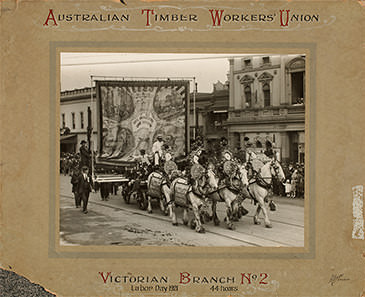Our History
The CFMEU Manufacturing Division has a long and proud history. Our Union is made up of four Unions who have all contributed to the struggle for improved wages and conditions for their members. These Unions are the Australian Timber Workers Union, The Federated Furnishing Trades Society, the Pulp and Paper Workers' Federation and the Federated Engine Drivers and Firemens' Association.
The following information provides an overview of the history of the CFMEU Manufacturing Division.
Background
The CFMEU Manufacturing Division was first registered as a Federal Organisation under the Commonwealth Conciliation and Arbitration Act (1904) on the 21st August 1907, as the Federated Sawmill, Timber-yard and Woodworkers Employees Association of Australasia.
The name of the Union was changed on the 27th October 1913 to the Amalgamated Timber Workers Union of Australia, and again on the 10th July 1918 to the Australian Timber Workers Union.
In late 1990 a ballot was conducted by members of the Australian Timber Workers Union and the Pulp and Paper Workers Federation of Australia endorsing the amalgamation of both Unions to form the Australian Timber and Allied Industries Union. A further ballot was conducted in mid 1991 on the amalgamation between the Australian Timber and Allied Industries Union and the Building Workers Industrial Union. This endorsement supported the first stage in the development of a major Union, the Construction, Forestry, Mining and Energy Union which represents approximately 120,000 members. The Forest and Furnishing Products Division represents approximately 20,000 members nationally.
The history of the CFMEU Manufacturing Division goes back to the 1870's campaign for the 8 hour working day, where it was at the forefront of the campaign. 1920 was the start of an on going struggle in the forest and forest products industry to reduce the 48 hour working week to 44 hours. The successful campaign resulted in Justice Higgins making an order to reduce the working hours of sawmillers in the metropolitan areas. Country sawmillers remained on 48 hours per week.
Almost 7 years later, employers tried to reintroduce the 48 hour week across the industry, claiming sawmills were closing and jobs being lost because of the impact of the 44 hour week.
In 1928 Judge Lukin gave his own interpretation of the award clause and reintroduced the 48 hour week.

There was controversy over the legitimacy of Judge Lukin's authority to alter or amend the award. In 1929 the case went to the full arbitration court, where the court hired an officer to investigate the claims made by employers about the effects of the 44 hour week and took into consideration Judge Lukin's interpretation of the award. The full arbitration court upheld Judge Lukin's decision of 1928 and the 48 hour week was consequently reintroduced across the country.
This was a time of great upheaval, when workers were subjected to violence, and imprisoned for standing up for their rights. in many instances, workers were locked out of their workplace by their employers.
As the reversion back to a 48 hour week affected only metropolitan workers, only 3000 of the 8000 workers in the industry supported the Union's campaign, resisting the employers' attacks and refusing to work the extra 4 hours unless paid overtime.
This dispute continued for two years in some States, before it returned to court and subsequently the industry reverted back to a 44 hour week.
The CFMEU Forest and Furnishing Products Division was one of the first Unions to achieve the 44 hour week and among the last to win it back. This had a devastating effect on the Union, which was financially crippled and brought to its knees. Despite the Union's exhausted financial situation, it maintained its struggle, never losing sight of the objective, which enabled the Union to continue and ultimately win back the 44 hour week. The very same passion and drive was responsible for restoring the financial viability of the Union.
Since 1996 the Coalition Government has introduced a hostile industrial environment intended to reduce wages and conditions and abolish many entitlements through so-called industrial workplace reforms.
One demonstration of the ruthlessness and determination of this government to attack workers and their Unions was the atrocious and illegal acts perpetrated on the Maritime Union of Australia (MUA) in 1999.
Michael O’Connor ascended to the position of the Forestry and Furnishing Division National Secretary in 2006, and began series of restructure and governance renewals in the face of numerous political, social and economic challenges. The National Office administration moved to Melbourne.
In 2007 the Forestry and Furnishing Division campaigned against the Howard Government’s WorkChoices agenda by initiating community education and establishing door knocking and protest actions. Organizers take a lead in bringing the message into workplaces and coordinating resistance within suburban, rural and regional communities. In timber/pulp and paper seats radical vote swings win at least ten seats for Labor.
Around the same time in Victoria, the Federated Furniture Trades Society (Vic FFTS) begins a formal integration with the National Office of the Forestry and Furnishing Division, which became the Manuifacturing Division in 2018.
Throughout 2007-18 the Manufacturing Division has run and won a variety of campaigns against decisions taken by large corporations and State and Federal Governments that threatened Australian jobs. Fighting for our members' jobs and improving wages and conditions remains the Union's number one priority.
The Textile Clothing Footwear Union amalgamated with the
CFMMEU
Manufacturing Division in 2018.
Textile, Clothing and Footwear members are now part of the
TCF Sector of the Manufacturing Division. The TCF industry is diverse and
encompasses a range of products and processes including (but not limited to)
design and manufacture, carpets, technical textiles, clothing, apparel,
accessories, footwear and components and allied industries and in the dry
cleaning and laundry industries.
The TCFUA was formed in 1992 after the Australian Textile
Workers Union ( formed 1919 ) amalgamated with the Clothing and Allied
Trades Union of Australia The Bookmakers union which was formed in 1907
had amalgamated with the Textile union prior to the amalgamation with the clothing
union.